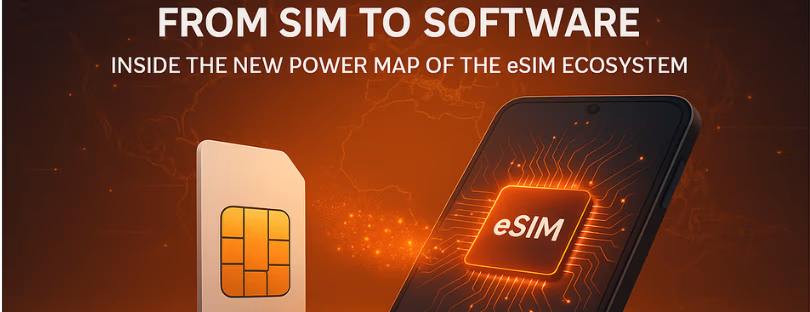
The Embedded Revolution: Why eSIM Market Growth is Poised to Surge
Imagine a world where switching mobile network providers on your phone or managing connectivity for countless IoT devices becomes a breeze. This futuristic vision is rapidly approaching, fueled by the rise of embedded SIM (eSIM) technology. But what exactly is an eSIM, and why is the eSIM market projected for significant growth in 2024 and beyond? eSIM Market Growth
An eSIM, essentially a miniature programmable chip, eliminates the need for physical SIM cards. Embedded directly into devices, eSIMs securely store an international mobile subscriber identity (IMSI) number, allowing users to seamlessly switch carriers or activate cellular plans remotely. This innovative technology unlocks a new era of connectivity convenience for both consumers and businesses.
A Market Poised for Takeoff: Drivers Fueling eSIM Growth
The eSIM market is on the cusp of a significant surge, driven by a confluence of powerful trends:
- IoT Boom: The ever-expanding landscape of Internet of Things (IoT) devices is a major growth catalyst. With billions of connected devices anticipated by 2031, the demand for eSIM’s remote provisioning and management capabilities for seamless global connectivity is skyrocketing.
- Smartphone Evolution: Leading smartphone manufacturers are embracing eSIM technology, integrating it into flagship models. This trend caters to user preferences for features like dual-SIM functionality and effortless carrier switching while traveling.
- Enterprise Embrace: Businesses across industries are recognizing the value proposition of eSIM-powered connectivity for their IoT and Machine-to-Machine (M2M) deployments. eSIMs enable automated cellular access provisioning at scale, pre- and post-deployment, streamlining operations for applications in asset tracking, smart cities, and more.
- Virtualization on the Rise: The telecommunications industry is witnessing a shift towards virtualized connectivity services. eSIM technology aligns perfectly with this trend, facilitating remote and flexible SIM provisioning independent of physical infrastructure. This empowers both mobile network operators and users with greater choice and control over cellular connectivity.
Unveiling the eSIM Market Landscape: Key Players and Opportunities
The eSIM market boasts a dynamic roster of prominent companies, including established players like Infineon Technologies and STMicroelectronics, along innovative startups. These players are vying for a slice of the lucrative market, fueled by the vast opportunities presented by: eSIM Market Growth
- Enterprise eSIM Solutions: The demand for robust eSIM-based connectivity platforms for mission-critical enterprise applications is anticipated to rise substantially. This presents significant growth potential for eSIM vendors catering to the business and infrastructure segments.
- Service Provider Innovation: Mobile network operators and virtual network operators are actively seeking to differentiate themselves through value-added eSIM solutions. This fosters a competitive environment that spurs continuous innovation in the eSIM market.
Beyond the Hype: Real-World Benefits of eSIM Adoption
The widespread adoption of eSIM technology promises a multitude of benefits that extend far beyond mere convenience:
- Enhanced User Experience: eSIMs empower users with greater control over their mobile plans, allowing for effortless switching between carriers and simplified activation processes. Imagine traveling abroad and instantly activating a local data plan without needing a physical SIM card.
- Streamlined Business Operations: For enterprises, eSIMs offer a pathway to significant operational efficiencies. Remote provisioning and management of cellular connectivity for vast IoT deployments translate into reduced costs and improved scalability.
- A More Connected Future: The ubiquity of eSIM technology has the potential to revolutionize the way we connect. From seamlessly managing smart home devices to ensuring uninterrupted connectivity for critical industrial equipment, eSIMs pave the way for a more interconnected and intelligent future.
Navigating the Future: eSIM Market Trends and Predictions
Looking ahead, the eSIM market is expected to witness a sustained growth trajectory, fueled by factors such as:
- Continued Growth of IoT Devices: The ever-expanding universe of connected devices will continue to drive demand for eSIM technology.
- 5G Rollout: The widespread deployment of 5G networks will further propel the need for advanced eSIM functionalities to manage the complexities of next-generation connectivity.
- Emerging Applications: As new use cases for eSIMs emerge in sectors like wearables and connected vehicles, the market is poised for further expansion.
These trends paint a promising picture for the future of eSIM technology. By staying abreast of these developments, businesses and individuals alike can capitalize on the numerous advantages offered by eSIM adoption.
Frequently Asked Questions: Demystifying the eSIM market Growth
1. Which companies are leading the eSIM market?
The eSIM market encompasses a diverse range of players, including established technology giants like Infineon Technologies AG, STMicroelectronics, Deutsche Telekom AG, Giesecke+Devrient Mobile Security GmbH, Thales Group, KORE Wireless, Arm Limited, Truphone Limited, Workz Group, Sierra Wireless, NXP Semiconductors, and AT&T, alongside innovative startups in the space.
2. What are the primary drivers influencing the eSIM market?
The eSIM market is propelled by a confluence of factors, including the surging popularity of IoT devices, the increasing adoption of eSIM technology by smartphone manufacturers, the growing demand for eSIM-powered connectivity solutions from enterprises, and the overall trend towards virtualized cellular connectivity services.
3. What are the key benefits of adopting eSIM technology?
eSIM adoption offers a multitude of advantages, including enhanced user experience through flexible carrier switching and simplified activation processes, streamlined business operations for enterprises via remote management of cellular connectivity for IoT deployments, and the potential to revolutionize how we connect in the future, from smart homes to industrial applications.
4. What does the future hold for the eSIM market?
The eSIM market is anticipated to experience continued growth, driven by the continuous expansion of the IoT landscape, the rollout of 5G networks, and the emergence of innovative applications for eSIM technology in sectors like wearables and connected vehicles.
5. How can I stay informed about the latest developments in the eSIM market?
Staying informed about the eSIM market can be achieved through various avenues, such as following industry publications and research reports, attending industry conferences and events, and keeping up with news from leading eSIM technology companies.
Conclusion: Embracing the Future of Connectivity with eSIM
The eSIM market is poised for a remarkable surge, fueled by a potent combination of technological advancements and evolving user and business needs. As eSIM technology becomes more ubiquitous, we can expect to witness a significant transformation in how we connect with the world around us. From enhanced user convenience to streamlined business operations and the potential to unlock a more interconnected future, eSIMs represent a revolutionary step forward in the realm of mobile connectivity.
- AIRALO
-
eSIM for
Europe
39 countries
-
1 GB – 7 days – €4.27
3 GB – 30 days – €11.09
10 GB – 30 days – €31.57
- AIRHUB
-
eSIM for
Europe
34 countries
-
1 GB – 7 days – €2.99
3 GB – 30 days – €5.12
10 GB – 30 days – €11-09
- aloSIM
-
eSIM for
Europe
32 countries
-
1 GB – 7 days – €5.00
3 GB – 30 days – €13.00
10 GB – 30 days- €36.00
- GigSky
-
eSIM for
Europe
36 countries
-
1 GB – 7 days – €6.99
3 GB – 15 days – €11.19
10 GB – 30 days – €27.99
- iRoamly
-
eSIM for
Europe
39 countries
-
1 GB – 7 day – €6.83
3 GB – 15 days – €10.24
10 GB – 30 days – €18.77
- Maya Mobile
-
eSIM for
Europe
34 countries
-
1 GB – 7 days – –
5 GB – 15 days – €5.99
10 GB – 30 days- €13.99
- NOMAD
-
eSIM for
Europe
36 countries
-
1 GB – 7 days – €4.71
3 GB – 15 days – €10.27
10 GB – 30 days – €15.41
- UBIGI
-
eSIM for
Europe
29 countries
-
500 MB – 1 day – €2.00
3 GB – 30 days – €8.00
10 GB – 30 days – €19.00
- VOIA
-
eSIM for
Europe
34 countries
-
1 GB – 7 days – €2.69
3 GB – 15 days – €5.05
10 GB – 30 days- €11.70




















